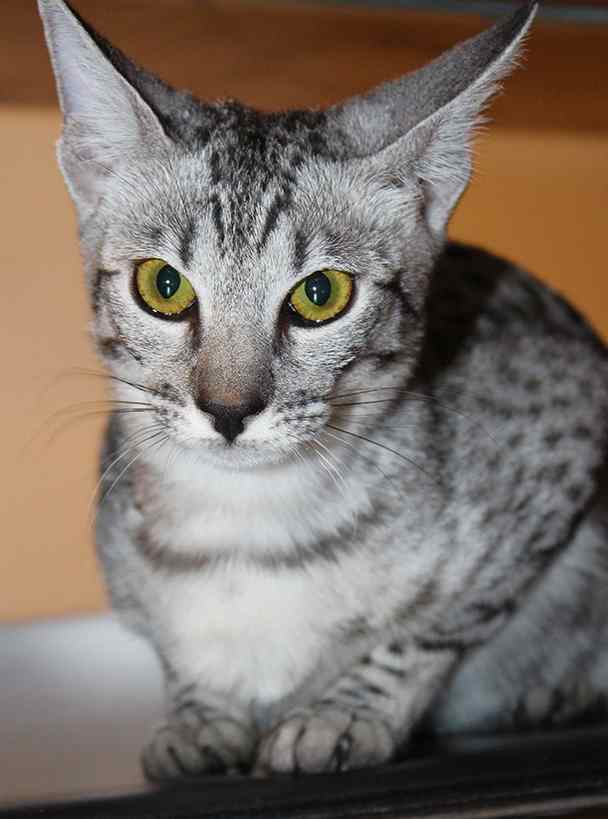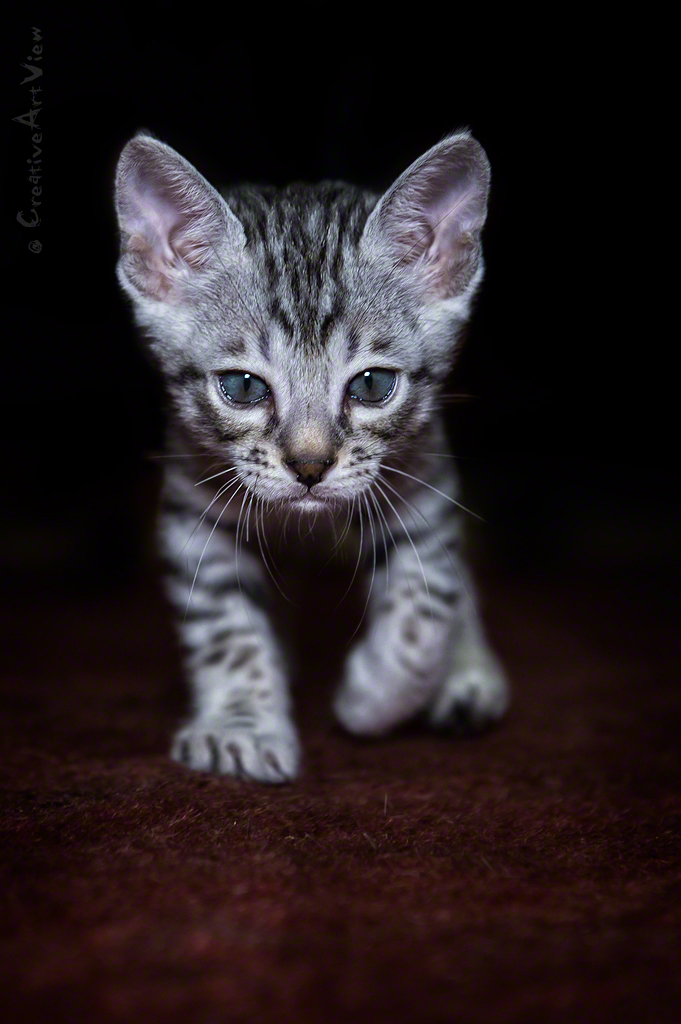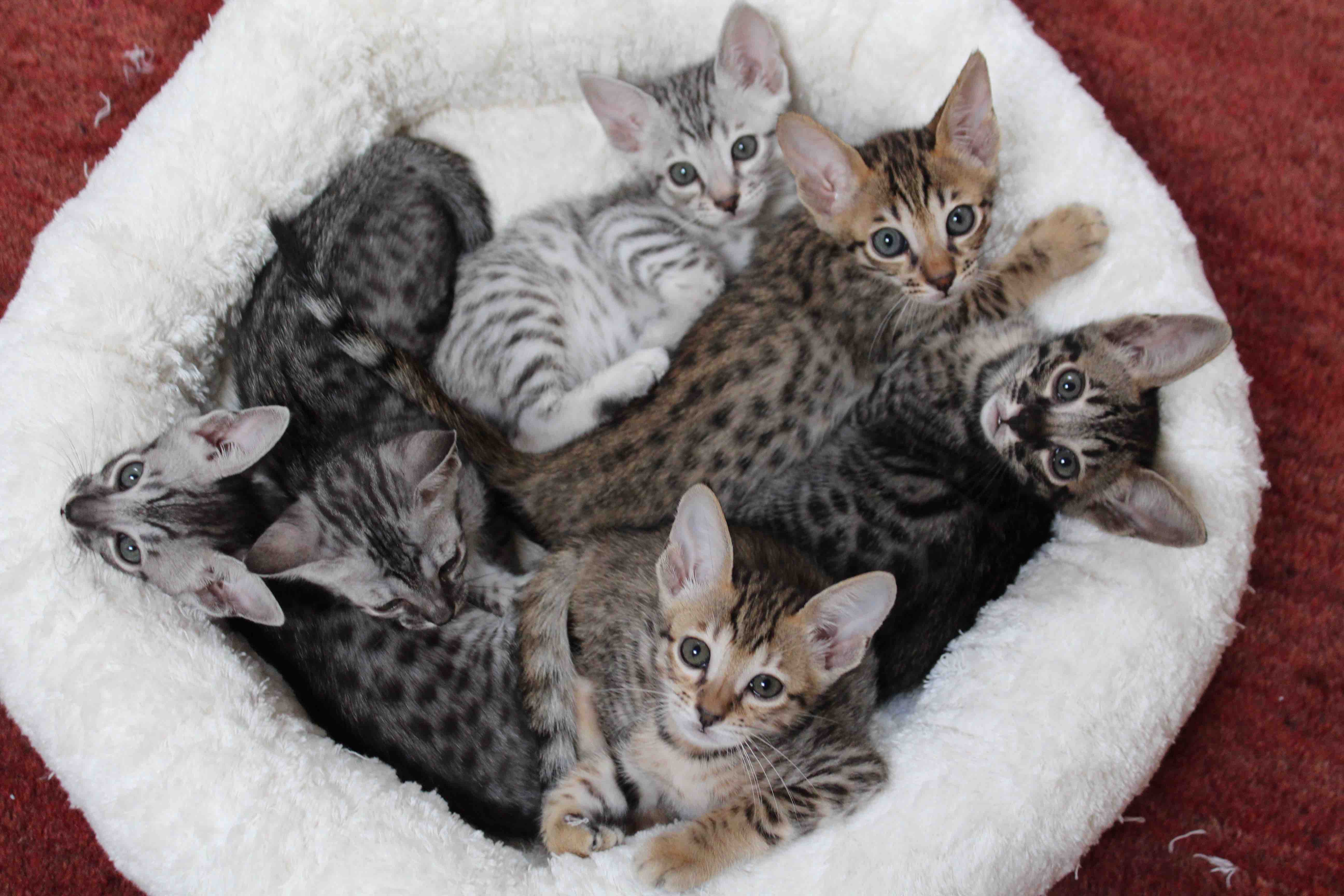The Savannah cat is a new breed of exotic cat named after the habitat of the serval, the savannah in Africa. The first Savannah cat appeared in the 1980s, following a chance pairing between an African serval (Leptailurus serval) and a Siamese cat. However, it was only in 1994 that a targeted attempt was made to breed the species by crossing several different pedigree cats with the African serval. The idea behind breeding the Savannah is to rear a cat that has the breathtaking beauty and graceful movement of the African serval, but that has the nature of a domestic cat that can be kept in the living room.
 Since he Savannah cat is descended from the African serval, it bears the wildcat’s genotype and possesses certain characteristics that are unique in the cat world. Savannah cats are very loving, intelligent animals that are capable of learning and that enjoy being touched. Like a dog, it follows their owner at every turn and wants to be a part of the family and involved in all its activities. If the owner does not give the Savannah cat the attention they feel they deserve, many Savannahs will help themselves to a little love bite, until they become the focal point once again. Unlike other cats, Savannah cats are not afraid of water and enjoy splashing around. They will fetch anything that can be thrown. Some Savannah cats even enjoy being taken for a walk on a leash. They are easily able to outjump a normal domestic cat. It is not uncommon for them to jump two meters from a standing position. All
Since he Savannah cat is descended from the African serval, it bears the wildcat’s genotype and possesses certain characteristics that are unique in the cat world. Savannah cats are very loving, intelligent animals that are capable of learning and that enjoy being touched. Like a dog, it follows their owner at every turn and wants to be a part of the family and involved in all its activities. If the owner does not give the Savannah cat the attention they feel they deserve, many Savannahs will help themselves to a little love bite, until they become the focal point once again. Unlike other cats, Savannah cats are not afraid of water and enjoy splashing around. They will fetch anything that can be thrown. Some Savannah cats even enjoy being taken for a walk on a leash. They are easily able to outjump a normal domestic cat. It is not uncommon for them to jump two meters from a standing position. All  Savannah cats are extremely talkative and exercise their voices accordingly in a wide range of sounds. Some Savannahs make the fur on their back and tail stand on end when they are happy, just like the serval. First- and second-generation Savannah cats (see breed) are larger and above all, taller than most domestic cats. F3 cats and all animals from later generations are smaller in size and yet retain their long legs, big ears and their wild appearance. Males are usuall larger than their female siblings. Savannahs are fully grown by the time they reach three years old. Males from earlier generations, up to and including the fourth generation, are usually sterile. In spite of their ancestry, Savannah cats from the third generation onwards are more similar to other domestic cats in terms of care (see hybrid laws and regulations).
Savannah cats are extremely talkative and exercise their voices accordingly in a wide range of sounds. Some Savannahs make the fur on their back and tail stand on end when they are happy, just like the serval. First- and second-generation Savannah cats (see breed) are larger and above all, taller than most domestic cats. F3 cats and all animals from later generations are smaller in size and yet retain their long legs, big ears and their wild appearance. Males are usuall larger than their female siblings. Savannahs are fully grown by the time they reach three years old. Males from earlier generations, up to and including the fourth generation, are usually sterile. In spite of their ancestry, Savannah cats from the third generation onwards are more similar to other domestic cats in terms of care (see hybrid laws and regulations).
As well as the provisions for keeping Savannah cats that should be noted, certain points must be adhered to in terms of feeding and medication. Savannah cats should be fed with high-quality feed. It has to be nutritious and balanced in composit ion and contain all of the necessary proteins, minerals and trace elements. The Savannah cat also loves to eat raw and cooked chicken. The feed must be free from carbohydrates, which is difficult for Savannah cats to digest and may lead to intestinal Problems. As a result of the genetic influence of the African serval, Savannah cats have smaller livers than normal domestic cats. This has to be taken into account when giving them medication that has to be metabolized by the liver, since the strength of the medicine’s effects and side effects may be different. Savannah cats have been known to display intolerances to the anesthetic ketamine, which means that this sedative should be avoided completely. Savannah cats are also highly sensitive to vaccines. Similarly as with wildcats, they should be vaccinated using an inactivated vaccine – that is, a vaccine that is not made of replicable pathogens or their key components.
ion and contain all of the necessary proteins, minerals and trace elements. The Savannah cat also loves to eat raw and cooked chicken. The feed must be free from carbohydrates, which is difficult for Savannah cats to digest and may lead to intestinal Problems. As a result of the genetic influence of the African serval, Savannah cats have smaller livers than normal domestic cats. This has to be taken into account when giving them medication that has to be metabolized by the liver, since the strength of the medicine’s effects and side effects may be different. Savannah cats have been known to display intolerances to the anesthetic ketamine, which means that this sedative should be avoided completely. Savannah cats are also highly sensitive to vaccines. Similarly as with wildcats, they should be vaccinated using an inactivated vaccine – that is, a vaccine that is not made of replicable pathogens or their key components.
Different generations – different personalities
- F1 Savannahs:
Since these cats have the greatest proportion of wildcat blood, they have also retained certain characteristics typical to wild animals including, but not limited to, their appearance. They are particularly quick when playing and are very deft at hunting field mice. They demand a lot of time, attention and affection so that they maintain their loving nature. F1 Savannah cats track down their favorite people, whom they do not let out of their sight, and cover them with smooch attacks, including the typical head butts. Along with a spacious house, these cats should also be given access to an outdoor enclosure or a secured garden.
- F2 Savannahs:
F2 Savannah cats display a great deal of similarities with the first generation in terms of their nature and their requirements. However, the lower proportion of wild-animal blood means they are a little quieter and more measured and don’t require quite as much time – but they do still have that exotic look. The F2 cat also loves to take a nap on the sofa from time to time. These cats should also be given access to an outdoor enclosure or a secured garden.
- F3 Savannahs:
In third-generation Savannahs, the wild-animal takes more of a back seat and the characteristics of the domestic cat paired with the social behavior of the serval come to the fore. F3 Savannah cats are more predictable in their behavior and easier to second-guess than the previous generations, yet still have that shot of wild-animal blood that makes them incredibly fast, affectionate and very special.
- F4 Savannahs:
F4 cats are very friendly and curious and always want to be in the middle of the action. They are very intelligent and playful, always on the lookout for playmates. This behavior makes them the perfect companions for children and other pets.
- SBT Savannahs (F5, F6 and so on):
SBT Savannahs are very honest and very affectionate cats. Their playfulness and allegiance mean they are very loyal, never belatedly, and show a lot of love and affection. They have the dog-like characteristics of the earlier generations, coupled with the demands of a domestic cat that can be kept in the living room, which makes them the perfect addition to the family.

